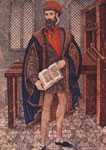Related Topics
Philadelphia Physicians
Philadelphia dominated the medical profession so long that it's hard to distinguish between local traditions and national ones. The distinctive feature is that in Philadelphia you must be a real doctor before you become a mere specialist.
Art in Philadelphia
The history of art, particularly painting and sculpture, has been a long and distinguished one. If you add in the art schools, the Philadelphia national influence on artists has been a dominant one.
Conventions and Convention Centers
When you have a big convention center, some circus is always coming to town. Philadelphia has always been a convention town, has had and still has lots of convention sites, and hopes to have more of the kind of famous convention we have had in the past.
Montgomery and Bucks Counties
The Philadelphia metropolitan region has five Pennsylvania counties, four New Jersey counties, one northern county in the state of Delaware. Here are the four Pennsylvania suburban ones.
City Hall to Chestnut Hill
There are lots of ways to go from City Hall to Chestnut Hill, including the train from Suburban Station, or from 11th and Market. This tour imagines your driving your car out the Ben Franklin Parkway to Kelly Drive, and then up the Wissahickon.
Philadelphia Reflections (6)
New topic 2017-02-06 21:23:28 description
The Barnes Foundation: Comments on the Economics of Art (2)

In 1951, Albert C. Barnes' legacy included Jerome's Epistle to Paulinus from the Gutenberg Bible education centered on a notable collection of illustrative artworks, housed in a museum of his own general design for the purpose. He left a multi-million dollar endowment to support his rather detailed and, in the opinion of many, somewhat eccentric intentions. It was his money, however, so his word was final. The institution was fairly mature, having previously been in operation under his direct control for twenty-five years.
Since the Foundation trustees are now before the Orphans Court pleading for permission to modify Dr. Barnes' instructions in order to avoid financial collapse, skepticism is inevitable. Obviously, the successor trustees must explain their expenses. But quite a plausible case can be made that the true cause of this disaster is inherent in the huge windfall growth in value of the paintings. In short, growth in value of the fine art may have outstripped the growth of the resources set aside for maintenance.

|
| Johann Gutenberg, creator of mass produced books, died in poverty |
Let's make a benchmark of the Gutenberg Bible, where incomplete copies are currently selling for $100,000 a page and complete copies are estimated to be worth $100 million apiece. Dealers maintain the Gutenberg is increasing in value at 20% a year, but growth seems closer to 9% a year if you go back to 1951. What's really relevant here is the growth in cost to ensure, protect, dehumidify, display and make it available to scholars, if not the public. It seems safe to guess these maintenance costs have grown more rapidly than the investment growth of the endowment, which is surely closer to 4% than 20%. The imbalance is even greater if you remember that some investment income is spent every year, while the worth of the fine art just grows and grows. Regardless of the true numbers, if the cost of maintaining the art does grow even slightly faster than the endowment, the dilemma the Barnes is now facing will eventually face any museum. New sources of revenue, either from the government or from public admissions, eventually becomes necessary if the priceless art remains on display. It is displaying these things that cost money; burying them under an Aztec mound or a German salt mine shelters them from the problem. In the case of Alfred Barnes, it is not completely certain that he wanted them displayed.
There is also the issue of quirky fluctuations in the market for fine art. The 22 known perfect copies of Gutenberg, Bibles have been around for almost five hundred years, and it is safe to say their value is enduring. The 180 paintings by Renoir now owned by the Barnes may prove to be Gutenberg Bibles or they may prove to be a passing fad, but it is pretty hard to believe that one of them will always be worth two Gutenbergs. Since there is a pretty fair chance that we are currently seeing a value bubble in French Impressionist painting, it is questionably prudent to shipwreck the whole Barnes Foundation, the School, or Albert C. Barnes basic intent, by resisting the sale of even one of the more overpriced examples in the collection at the top of the market.
That's one side of it. Another consideration is that Barnes himself did considerable merger negotiation with other museums, and may have been unexpectedly killed in an auto accident before he turned over all his cards in that particular poker game. It's asking a lot of the poor judge to overturn the clear and largely unmistakable language of Barnes will in favor of theories about what Barnes was really really thinking when he wrote it. If the judge is feeling adventurous, it's probably more satisfying to all parties if he sets forth a new legal doctrine, reflecting the inevitable disparity between the cost of displaying fine art to the public, and providing a perpetual endowment to do so.
Originally published: Tuesday, November 02, 2004; most-recently modified: Thursday, June 06, 2019
| Posted by: cheapostay discount | Feb 13, 2012 9:46 AM |
| Posted by: esalerugs promo code | Feb 13, 2012 9:24 AM |